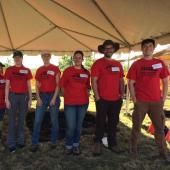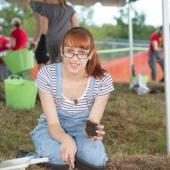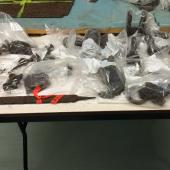
Using measuring tapes to layout the dig site and find the location of the last dig in 1992.

A tent going up to provide shelter for the dig. Small stumps left from clearing the land were marked by orange pylons so trip hazards could be avoided.

Sod was removed to open up 7 dig units

Industrial Heritage NS had a booth to provide information on iron founding and the buildings that were once on the Albion foundry site.

Thanks to our sponsors: Town of New Glasgow and Birchwood Campgrounds.
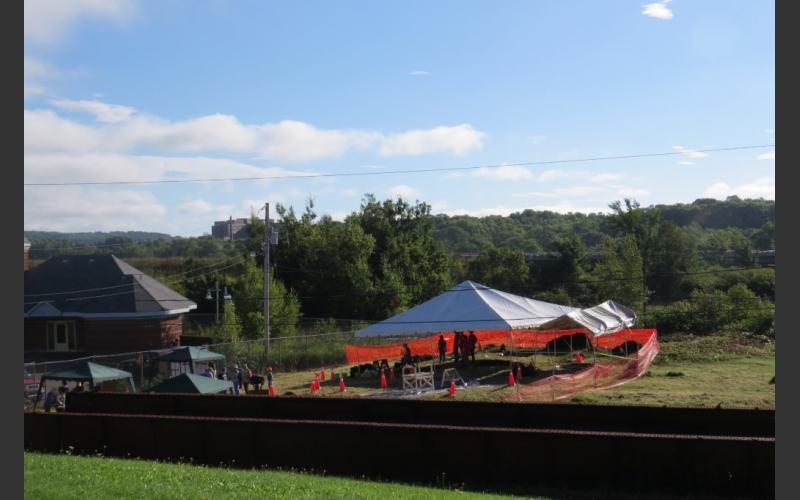
Orange fencing kept participants out of potentially hazardous areas and the white tents provided protection from the sun.

Seven archaeologists volunteered their time to guide the work of participants. The number of archaeologists determined the number of amateur diggers that could be registered. They wore red Museum of Industry shirts so that they could be identified for questions.
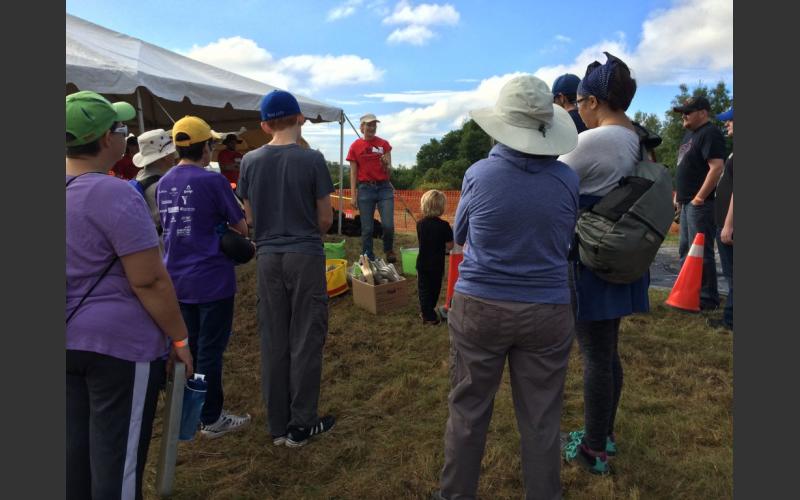
Lead archaeologist Laura instructed the diggers. She obtained the permit for the dig which gives her legal permission to carry out this archaeological research. She is responsible to conduct it in a professional manner. She must ensure the work is properly recorded, process all items found and submit a report to the government.
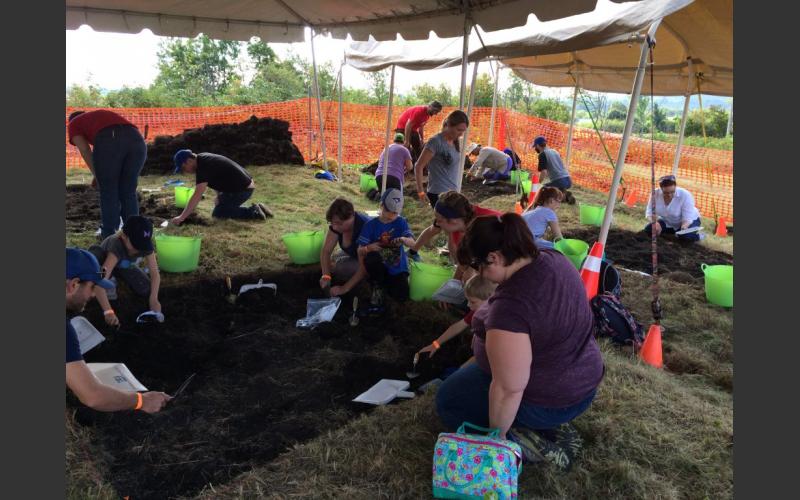
The dig begins. There is no guarantee anything will be found.

Participants used trowels to dig dirt, small brooms to brush, dustpans to lift dirt into the green trugs that were then taken to a sifter.

Dirt in trugs was dumped on a sifter and shaken until it fell through mesh screening, leaving any items behind. The screen is lifted to remove any stubborn clumps of dirt that do not fall away by shaking.
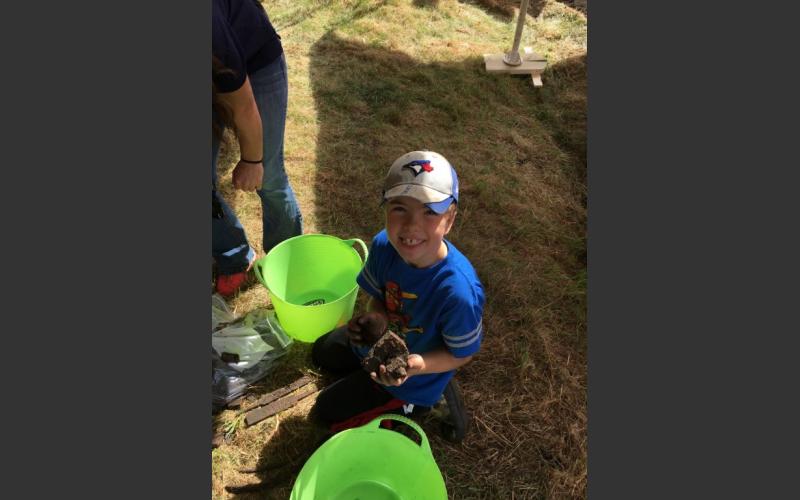
Found something! Nobody takes anything home as everything discovered belongs to all Nova Scotians and cannot be claimed as private property.

The dig unit is like a dirt layer cake. A layer of soil reveals information about time periods and helps date items. Each layer must be removed evenly across the dig area.

Another piece of iron is found.

One person shakes the sifter, another watches for items to emerge as the dirt falls through, and an archaeologist helps out.

Using trowels to scrape the dirt as flat as possible was fun.

An archaeologist recorded changes in soil at each level and noted the location of objects as they were found.

A day to remember.

A heavy iron item emerged from the soil.

There were many pieces of metal and some bricks unearthed.

A few portable and one stationary sifter were available to process the dirt taken out of the dig units. Piles of dirt were periodically shoveled out of the way of the sifters.

Archaeology is careful work.

One dig unit found a lot of small pieces of iron. We will do our best to identify it all as we clean and photograph it in the months to come.

The archaeologists had lots of fun helping diggers.

Everyone enjoyed the rewards of the day.

A toothbrush can help clear away clumps of mud to assist in identification of the items found.

Some participants liked using the sifter as much as digging.

One unusual find was a 1928 nickel

An archaeologist examining a digger’s find.

So far, this section of cast iron fish belly rail is the most interesting find. All four groups of diggers had participants who worked at exposing the rail. It is 74” long.

What is it? Industrial Heritage Nova Scotia helped identify some items on the spot. Some will require more research.

Part of the archaeological documentation was to put everything found into Ziploc bags with location identifying information. Next steps will be to clean with toothbrushes and photograph. A selection of items will have chemical conservation treatments to preserve them.

This chair that would have held a piece of fish belly rail onto the track of the Albion Railway will be conserved.

The fish belly rail sits in distilled water to prevent corrosion until it has a chemical bath to remove chlorides that would have covered it when it was buried. This will stabilize it for future display.
 Using measuring tapes to layout the dig site and find the location of the last dig in 1992.
Using measuring tapes to layout the dig site and find the location of the last dig in 1992. A tent going up to provide shelter for the dig. Small stumps left from clearing the land were marked by orange pylons so trip hazards could be avoided.
A tent going up to provide shelter for the dig. Small stumps left from clearing the land were marked by orange pylons so trip hazards could be avoided. Orange fencing kept participants out of potentially hazardous areas and the white tents provided protection from the sun.
Orange fencing kept participants out of potentially hazardous areas and the white tents provided protection from the sun. Seven archaeologists volunteered their time to guide the work of participants. The number of archaeologists determined the number of amateur diggers that could be registered. They wore red Museum of Industry shirts so that they could be identified for questions.
Seven archaeologists volunteered their time to guide the work of participants. The number of archaeologists determined the number of amateur diggers that could be registered. They wore red Museum of Industry shirts so that they could be identified for questions. Lead archaeologist Laura instructed the diggers. She obtained the permit for the dig which gives her legal permission to carry out this archaeological research. She is responsible to conduct it in a professional manner. She must ensure the work is properly recorded, process all items found and submit a report to the government.
Lead archaeologist Laura instructed the diggers. She obtained the permit for the dig which gives her legal permission to carry out this archaeological research. She is responsible to conduct it in a professional manner. She must ensure the work is properly recorded, process all items found and submit a report to the government. The dig begins. There is no guarantee anything will be found.
The dig begins. There is no guarantee anything will be found. Participants used trowels to dig dirt, small brooms to brush, dustpans to lift dirt into the green trugs that were then taken to a sifter.
Participants used trowels to dig dirt, small brooms to brush, dustpans to lift dirt into the green trugs that were then taken to a sifter. Dirt in trugs was dumped on a sifter and shaken until it fell through mesh screening, leaving any items behind. The screen is lifted to remove any stubborn clumps of dirt that do not fall away by shaking.
Dirt in trugs was dumped on a sifter and shaken until it fell through mesh screening, leaving any items behind. The screen is lifted to remove any stubborn clumps of dirt that do not fall away by shaking. Found something! Nobody takes anything home as everything discovered belongs to all Nova Scotians and cannot be claimed as private property.
Found something! Nobody takes anything home as everything discovered belongs to all Nova Scotians and cannot be claimed as private property. The dig unit is like a dirt layer cake. A layer of soil reveals information about time periods and helps date items. Each layer must be removed evenly across the dig area.
The dig unit is like a dirt layer cake. A layer of soil reveals information about time periods and helps date items. Each layer must be removed evenly across the dig area. Another piece of iron is found.
Another piece of iron is found. One person shakes the sifter, another watches for items to emerge as the dirt falls through, and an archaeologist helps out.
One person shakes the sifter, another watches for items to emerge as the dirt falls through, and an archaeologist helps out. Using trowels to scrape the dirt as flat as possible was fun.
Using trowels to scrape the dirt as flat as possible was fun. An archaeologist recorded changes in soil at each level and noted the location of objects as they were found.
An archaeologist recorded changes in soil at each level and noted the location of objects as they were found. A day to remember.
A day to remember. A heavy iron item emerged from the soil.
A heavy iron item emerged from the soil. There were many pieces of metal and some bricks unearthed.
There were many pieces of metal and some bricks unearthed. A few portable and one stationary sifter were available to process the dirt taken out of the dig units. Piles of dirt were periodically shoveled out of the way of the sifters.
A few portable and one stationary sifter were available to process the dirt taken out of the dig units. Piles of dirt were periodically shoveled out of the way of the sifters. Archaeology is careful work.
Archaeology is careful work. One dig unit found a lot of small pieces of iron. We will do our best to identify it all as we clean and photograph it in the months to come.
One dig unit found a lot of small pieces of iron. We will do our best to identify it all as we clean and photograph it in the months to come. The archaeologists had lots of fun helping diggers.
The archaeologists had lots of fun helping diggers. Everyone enjoyed the rewards of the day.
Everyone enjoyed the rewards of the day. A toothbrush can help clear away clumps of mud to assist in identification of the items found.
A toothbrush can help clear away clumps of mud to assist in identification of the items found. Some participants liked using the sifter as much as digging.
Some participants liked using the sifter as much as digging. One unusual find was a 1928 nickel
One unusual find was a 1928 nickel An archaeologist examining a digger’s find.
An archaeologist examining a digger’s find. So far, this section of cast iron fish belly rail is the most interesting find. All four groups of diggers had participants who worked at exposing the rail. It is 74” long.
So far, this section of cast iron fish belly rail is the most interesting find. All four groups of diggers had participants who worked at exposing the rail. It is 74” long. What is it? Industrial Heritage Nova Scotia helped identify some items on the spot. Some will require more research.
What is it? Industrial Heritage Nova Scotia helped identify some items on the spot. Some will require more research. Part of the archaeological documentation was to put everything found into Ziploc bags with location identifying information. Next steps will be to clean with toothbrushes and photograph. A selection of items will have chemical conservation treatments to preserve them.
Part of the archaeological documentation was to put everything found into Ziploc bags with location identifying information. Next steps will be to clean with toothbrushes and photograph. A selection of items will have chemical conservation treatments to preserve them. This chair that would have held a piece of fish belly rail onto the track of the Albion Railway will be conserved.
This chair that would have held a piece of fish belly rail onto the track of the Albion Railway will be conserved. The fish belly rail sits in distilled water to prevent corrosion until it has a chemical bath to remove chlorides that would have covered it when it was buried. This will stabilize it for future display.
The fish belly rail sits in distilled water to prevent corrosion until it has a chemical bath to remove chlorides that would have covered it when it was buried. This will stabilize it for future display.








